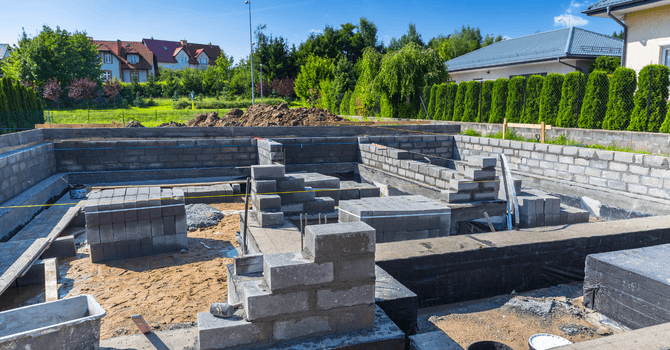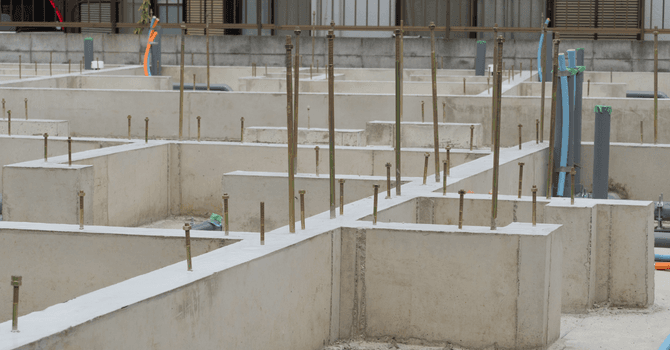What's the Difference Between Formwork and Foundation?
By Editorial Team
Updated on November 7, 2023

Building a house involves a series of steps, the first one being earthwork, which consists of cleaning and preparing the land on which the structure will be built. Next up, pouring the foundation, which is a crucial step that ensures the solidity of the structure and the house’s structural strength through the years.
The foundation is, first and foremost, the base of the house, and it governs the weight distribution across the ground. To prevent any sort of unfortunate outcomes during the house-building process, it’s best to carry out a land and soil survey prior to undertaking any work. Based on the condition of the soil, the contractor will then be able to assess the depth at which the foundation should be poured.
Moreover, the formwork is basically a mould, in which the labourers will pour concrete and, once cured, it will make up the foundation. Check out our article to know everything about formwork and foundations, two of the initial house-building steps.
The Difference Between Formwork and Foundation
Building a house: The value of the foundation

Source : Canva
The foundation’s structural strength ultimately depends on the type of soil on which it’s erected, as well as the quality of the materials used during the course of the construction process. Made of stone, concrete, and reinforcement metal, the foundation is anchored into the ground and ensures the house’s stability.
Based on the soil’s specificity, the contractor will be able to determine to what depth the foundation should be poured. If the house is built on clayey soil, the foundation will be relatively deep as opposed to a foundation poured into rocky soil, where it doesn’t require as much anchorage, since the rocks are, by nature, very solid.
Once the foundation is done, the next step is to pour a slab and mount the walls. Note that walls mounted on a solid and decent base are less likely to crack and break down over the years. As such, the foundation (the slab on which the structure rests) must be in accordance with the weight and the building’s surface at the risk of the residence collapsing. Best-case scenario, the house can be saved by means of repairing or replacing the foundations, or worst-case scenario, the house will be demolished.
On account of the structural strength of the foundations, maintenance and renovation work won’t be as complex, or as costly. To ensure the condition of your foundations, the best recourse is to hire a building professional (architectural technologist, architect, or structural engineer). This is all the more important if you plan on putting your house on the market and would like to ensure there are no hidden defects. In fact, if the buyer discovers a significant fissure in the foundation after purchasing the house, they’re legally allowed to sue you for a latent defect.
Replacing Your House’s Foundation

Source : Canva
The foundation is indeed a structural component of your dwelling. A poorly made foundation can result in the building’s structural weakening, which often happens when renovation work isn’t undertaken in time. If you suspect problems ensuing from fissures, water infiltration, or uneven basement flooring, you absolutely must be proactive and rectify the situation right away.
Foundation renovation work can be quite expensive, especially if it requires heavy machinery and preliminary surveys to properly plan out the project. Also, note that this type of work requires both monitoring the safety of the house as well as that of the workers who are working beneath it.
Are you experiencing a problem with your foundation? Here’s a related article about the cost of foundation repairs.
What’s Formwork and How’s it Made?

Photo: Wikimedia Commons
What’s the purpose of formwork?
The formwork is a temporary mould in which concrete is poured until it has completely cured. This element is vital in establishing the shape of the structure being built.
What are the different types of formwork?
Made of steel or repurposed wood, side panels making the formwork are assembled one by one, with the goal of shaping the formwork’s panels. It’s super important that these panels are very straight with clear and defined edges to guarantee the foundation's stability.
When should the concrete formwork be removed?
Once the concrete foundation has cured, it becomes self-supporting. The next step will consist of removing the formwork, meaning the workers will remove all retaining panels. The hardest part resides in removing the planks holding the dry concrete. The challenge is removing said panels without so much as damaging the foundation’s concrete. For that reason alone, a lot more builders are using formwork that has been coated in oil made specifically for removing said mould so that the panels can be easily removed. Note that some formwork can be repurposed, on the other hand, others like insulating concrete formwork cannot.
Using Insulating Concrete Formwork to Shield Foundations

Photo: Wikimedia Commons
The advancements made in regard to residential construction are such that engineers are multiplying innovations to improve the performance of new constructions. Said formwork consists of two cast-like panels containing high-density polystyrene inserts and is assembled prior to the concrete being poured.
Insulating formwork panels are more efficient than traditional moulds since they're embedded in the concrete. As a result, the home's energy performance is also optimized.
Why should formwork be insulated?
The advantages of insulated formwork are relatively extensive:
Improves soundproofing of exterior walls;
Provides up to 3-hour fire protection;
Enhances the comfort of the flooring;
Has a stable and constant energy efficiency;
Facilitates energy savings;
Concrete poured into insulating formwork will withstand humidity, insects, and other types of deterioration that can occur over a lengthy period of time.
Some mistakenly think that insulating concrete formwork isn’t as valuable construction-wise since it’s more expensive than standard formwork, however, this technique is especially interesting in terms of value for money. As a matter of fact, labourers spend less time assembling the panels making up the formwork, which cuts back on their work hours. More so, this technique allows extending the walls all the way to the roof to create some kind of perfect continuity between the insulation and the structure, while also reinforcing the home’s energy efficiency.
Get 3 quotes for your foundation renovation project
RenoQuotes.com can help you get quotes for your foundation renovation project. By submitting your project, we’ll put you in contact with top-rated contractors. Fill in the form on the homepage (it only takes a few minutes), and you will get estimates from trusted professionals.
Dial 1-844 828-1588 to speak with one of our customer service representatives.
Looking for something else?
Related articles
The latest industry news, interviews, technologies, and resources.

Editorial Team
•15 Jan 2025
Is your home contaminated with asbestos? Call in a professional decontamination company! Working with asbestos experts from a demolition company will save you from becoming just another number amongst those infected with asbestos in Quebec. Worldwide, 100,000 people die every year as a result of asbestos exposure.

Editorial Team
•26 Apr 2024
Foul smells, poorly draining water, loud and strange pipe noises, overflowing content… Septic tanks rely on a system that’s more susceptible to damage than a municipal sewer network, so you have to be mindful of how waste is disposed of and pay special attention to the slightest warning sign that there might be an issue with the system.

Léa Plourde-Archer
•07 Nov 2023
After months of preparing for our big renovation project, we finally got down to business and met with an interior designer. We chose to work with Vivre Autrement, a company led by designer Valérie Bourget.

Équipe éditoriale
•24 Sep 2024
Do you appreciate old houses and their unique charm? If you're about to buy one or renovate the one you're currently living in, here are some ideas to inspire you!

Équipe éditoriale
•10 Dec 2024
It’s no secret that over the past few years, green construction has grown in popularity and for good reason! An ecological home is trendy due to its green efficiency, its lack of carbon footprint as well as its eco-friendly capabilities.